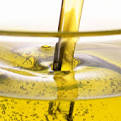













Carrot Seed- Dacus Carota
Family: Apiaceae (Umbelliferae)
Synonyms: Wild carrot, Queen Anne's lace, Bird's nest.
General Description: Annual or biennial herb, with a small indebile, tough whitish root. it has a much-branched stem up to 1.5 metres high with hairy leaves and umbels of white lacy flowers.
Distribution: Native to Europe, Asia and North Africa; naturalized in North America. The essential oil is mainly produced in France.
Other Species: An oil is also produced by solvent extraction from the red fleshy root of the common edible carrot (D. carota subspecies sativus) mainly for use as a food colouring.
Herbal/Folk Tradition:A higly nutritious plant, containing substancial amounts of Vitamins A, C, B, and B2. The roots have a strong tonic action on the liver and gall bladder, good for the treatment of jaundice and other complaints. The seeds are used for the retention of urine, colic, kidney and digestive disorders, anad to promote messtruation. In the Chinese tradition it is used to treat dysentery and to expel worms.
The dried leaves are current in the British Herbal Pharmacopoeia for calculus, gout, cystitis and lithuria.
Actions:Antihelmetic, antiseptic, carminative,depurative, diuretic, emmenagogue, hepatic, stimulant, tonic, vasodilatory and smooth muscle relaxant.
Extraction:Essential oil by steam distillation from the dried fruit (seeds).
Characteristics: A yellow or amber -coloured liquid with a warm, dry, woody-earthy odour. It blends well with costus, cassie, mimosa, cedarwood, geranium, citrus and spice oils.
Principal Constituents:Pinene, carotol, daucol, limonene, bisabolene, elmene, geraniol, geranyl acetate, caryophyllene, among others.
Safety Data: Non-toxic, non-irritant, non-sensitizing.
Aromatherapy/Home Use
Skin care: Dermatitis, eczema, psoriasis, rashes,revitalizing and toning, mature complexions, wrinkles.
Circulation muscles and joints:Accumulation of toxins, arthritis, gout, oedema, rheumatism.
Digestive system: Anaemia, anorexia, colic,indegestion, liver congestion.
Genito-urinary and endocrine systems:Amenorrhoea, dysmenorrhoea, glandular problems, PMT.
Other Uses: Fragrance component in soaps, detergents, cosmetics and perfumes. Flavour ingredient in most major food categories, especially seasonings.
Reference: The Encyclopedia of Essential Oils; Julia Lawless
Articles Latest
- Chamomile Roman - Chamaemelum nobile
- Chamomile Maroc - Ormenis multicaulis
- Chamomile German - Matricaria recutica
- From Biology To Aromatherapy
- Plant Messengers
- Celery Seed-Apium graveolens
- Cedarwood Virginian - Juniperus virginiana
- Cedarwood, Texas- Juniperus ashei - Essential oils
- Cedarwood Atlas- Cedrus atlantica - Essential Oils
- Cassie - Acacia Farnesiana - sweet acacia
- Cassia - Cinnamomum Cassia
- Cascarilla Bark - Croton eluteria
- Carrot Seed- Dacus Carota
- CARDAMON
- CARAWAY
- CANANGA
- CAMPHOR
- CALAMUS
- Calamintha-Calamintha officinalis
- CAJEPUT- Melaleuca cajeputi
- Plant Expression
Articles-Most Read
- Home
- Balsam Canadian - Abies balsamea
- Balsam Peru
- Copaiba Essential Oil
- North America: Tea Tree and Monarda-3
- Basil French - Ocimum basilicum
- Basil Exotic
- North America: Tea Tree and Monarda-2
- Exploring Transcultural Constants
- Thyme Essential Oil
- Balsam Tolu
- Palma Rosa
- The Bioactivity of Essential Oils
- Bay - West Indian - Pimenta racemosa
- Benzoin - Styrax benzoin
- Why Pharmacology Cannot Demonstrate Essential Oil Efficacy
- Exploring Essential Oil Activity The Conventional Way
- Complex information From Plants
- Aromatherapy: An Answer
- Contacts
